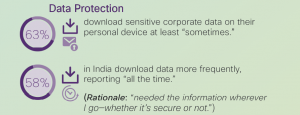































How well do you know your mobile worker? Understanding the mobile worker's perceptions and behaviors will offer a better view on the potential security implications your organization must manage. Cisco recently released a new global infographic and white paper, the Cisco Connected World International Mobile Security study. They explore the mobile worker's view points concerning working remotely, connecting to corporate, and their sense of security. Some of the findings are worth reflecting on to help you set the course for your mobile security efforts.
There is no question that the movement to mobile personal devices in the workforce has been well recognized. A recent response to this trend includes almost half of employers offering to fund workers to buy their own devices. Allowing the "chose your own" device alternative will attract and retain talent and reduce costs (see recent IBSG BYOD research), but what are the security implications?
There are a few striking data points to call out:
 So, who really owns the mobile security issue? Mobile workers do not take full responsibility for a safe device with 84% believing that their IT will protect them from threats no matter what device is used. Sometimes IT's perspective on this dependency is expressed with disbelief. An example of this issue was observed at BlackHat from a security professional during a demonstration we presented a couple weeks ago.
So, who really owns the mobile security issue? Mobile workers do not take full responsibility for a safe device with 84% believing that their IT will protect them from threats no matter what device is used. Sometimes IT's perspective on this dependency is expressed with disbelief. An example of this issue was observed at BlackHat from a security professional during a demonstration we presented a couple weeks ago.
During the demonstration, we were showing how a user who inadvertently clicked on a phony URL sent in an email. That click triggered to phone an alert to a hacker that an "innocent" user is accessing the phony Internet site. The user unknowingly offered login credentials to their bank account. The hacker begins to record the users' keystrokes to use later for malicious purposes. A security professional from BlackHat chimes in during the demonstration with the comment, "Dumb User."The demonstration later showed how the combined effort of Cisco ISE and SIEM (Lancope) with unique TrustSec enforcement can identify and control the malicious activity with a single policy (for example, by segmenting and restricting users traffic close to the edge-on a network switch). The surprise to the security experts watching the demonstration was the concept that the network switch provided this enforcement.
Bottom Line: Most mobile workers have good intentions but do rely on IT to step in.
It would be great hear from you on your impressions of these recent findings and whether you are a mobile worker or an IT professional.
Please refer to Cisco's security response for the mobile workforce: Secure Access
 Tags quentes :
Cisco Identity Services Engine (ISE)
Secure Access Service Edge (SASE)
Segurança Móvel
Bring your Own Device (BYOD)
TrustSec
Black Hat
Connected Word International Mobile Security
Tags quentes :
Cisco Identity Services Engine (ISE)
Secure Access Service Edge (SASE)
Segurança Móvel
Bring your Own Device (BYOD)
TrustSec
Black Hat
Connected Word International Mobile Security